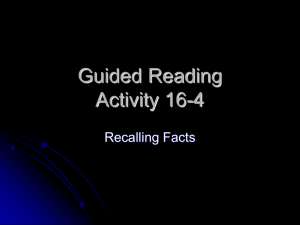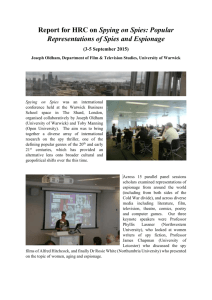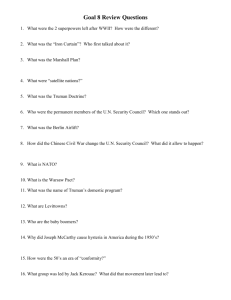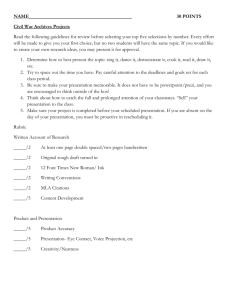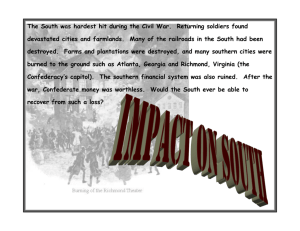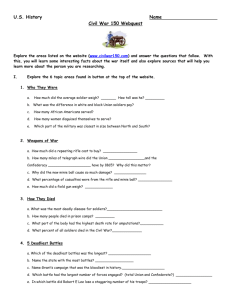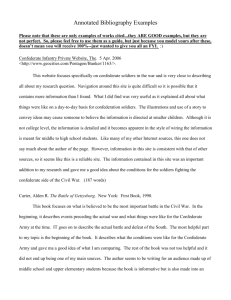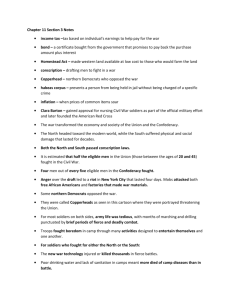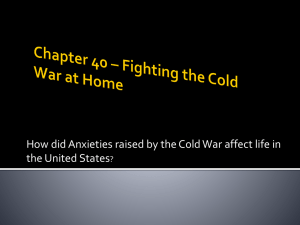Spies - Scarsdale Union Free School District
advertisement
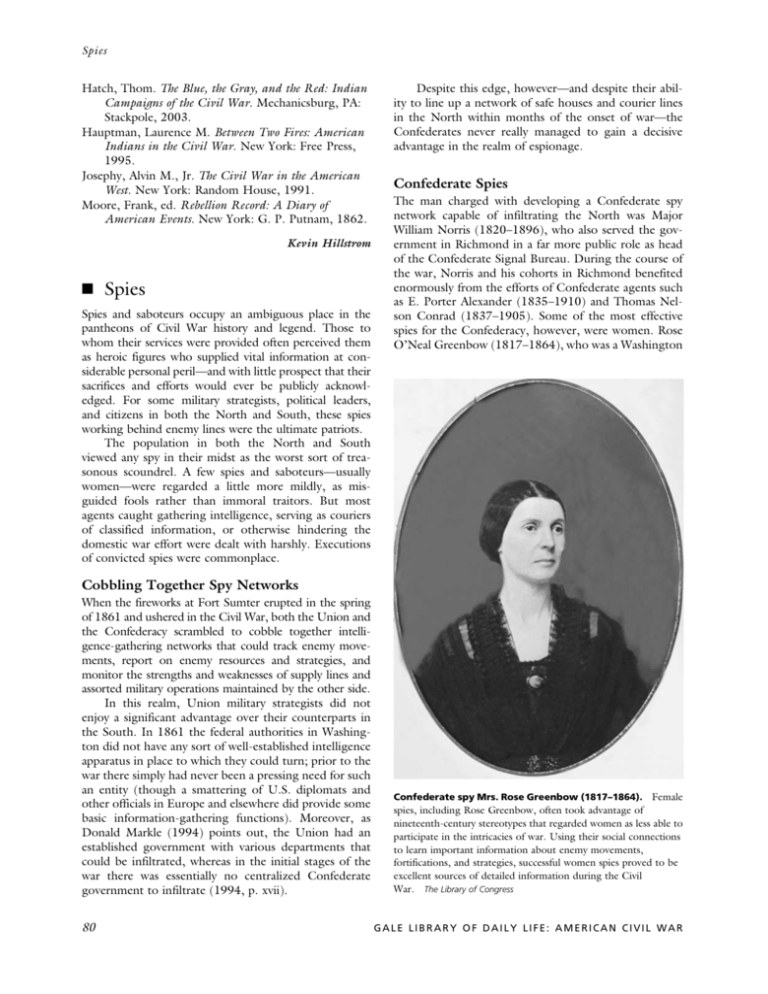
Spies Hatch, Thom. The Blue, the Gray, and the Red: Indian Campaigns of the Civil War. Mechanicsburg, PA: Stackpole, 2003. Hauptman, Laurence M. Between Two Fires: American Indians in the Civil War. New York: Free Press, 1995. Josephy, Alvin M., Jr. The Civil War in the American West. New York: Random House, 1991. Moore, Frank, ed. Rebellion Record: A Diary of American Events. New York: G. P. Putnam, 1862. Kevin Hillstrom n Spies Spies and saboteurs occupy an ambiguous place in the pantheons of Civil War history and legend. Those to whom their services were provided often perceived them as heroic figures who supplied vital information at considerable personal peril—and with little prospect that their sacrifices and efforts would ever be publicly acknowledged. For some military strategists, political leaders, and citizens in both the North and South, these spies working behind enemy lines were the ultimate patriots. The population in both the North and South viewed any spy in their midst as the worst sort of treasonous scoundrel. A few spies and saboteurs—usually women—were regarded a little more mildly, as misguided fools rather than immoral traitors. But most agents caught gathering intelligence, serving as couriers of classified information, or otherwise hindering the domestic war effort were dealt with harshly. Executions of convicted spies were commonplace. Despite this edge, however—and despite their ability to line up a network of safe houses and courier lines in the North within months of the onset of war—the Confederates never really managed to gain a decisive advantage in the realm of espionage. Confederate Spies The man charged with developing a Confederate spy network capable of infiltrating the North was Major William Norris (1820–1896), who also served the government in Richmond in a far more public role as head of the Confederate Signal Bureau. During the course of the war, Norris and his cohorts in Richmond benefited enormously from the efforts of Confederate agents such as E. Porter Alexander (1835–1910) and Thomas Nelson Conrad (1837–1905). Some of the most effective spies for the Confederacy, however, were women. Rose O’Neal Greenbow (1817–1864), who was a Washington Cobbling Together Spy Networks When the fireworks at Fort Sumter erupted in the spring of 1861 and ushered in the Civil War, both the Union and the Confederacy scrambled to cobble together intelligence-gathering networks that could track enemy movements, report on enemy resources and strategies, and monitor the strengths and weaknesses of supply lines and assorted military operations maintained by the other side. In this realm, Union military strategists did not enjoy a significant advantage over their counterparts in the South. In 1861 the federal authorities in Washington did not have any sort of well-established intelligence apparatus in place to which they could turn; prior to the war there simply had never been a pressing need for such an entity (though a smattering of U.S. diplomats and other officials in Europe and elsewhere did provide some basic information-gathering functions). Moreover, as Donald Markle (1994) points out, the Union had an established government with various departments that could be infiltrated, whereas in the initial stages of the war there was essentially no centralized Confederate government to infiltrate (1994, p. xvii). 80 Female spies, including Rose Greenbow, often took advantage of nineteenth-century stereotypes that regarded women as less able to participate in the intricacies of war. Using their social connections to learn important information about enemy movements, fortifications, and strategies, successful women spies proved to be excellent sources of detailed information during the Civil War. The Library of Congress Confederate spy Mrs. Rose Greenbow (1817–1864). GALE LIBRARY OF DAILY LIFE: AMERICAN CIVIL WAR Spies ‘‘BELLE’’ BOYD AND PAULINE CUSHMAN Some of the most notorious—and successful—spies on both sides of the Civil War were women. Perhaps the most colorful was Maria Isabella ‘‘Belle’’ Boyd (1844–1900), known as ‘‘the Cleopatra of the Secession.’’ Born in Martinsburg in what is now West Virginia, Boyd began her espionage work at the age of seventeen. When some drunken Union soldiers entered the family home on July 4, 1861, and insulted Belle’s mother, the teenager drew a pistol and shot one of them. As a result, a detachment of Union soldiers was posted around the house and the family’s activities were monitored. Belle took advantage of this close contact to charm one of the officers into revealing military secrets. It was a pattern she followed on other occasions, along with eavesdropping on Union officers through a knothole in the upper floor of the local hotel. Boyd was not universally admired in the Confederacy in spite of her repeated success in obtaining Union military secrets. She was a flamboyant dresser, preferring richly colored clothes and wearing a feather in her hair. She also traveled alone, often on horseback, and visited Southern officers in their camp tents—behavior that shocked other women. Arrested twice and imprisoned for espionage, Boyd was released both times. In 1864 she went to England, where she met and married an officer in the Union Navy, Samuel Wylde Hardinge. After his death, she remained in England and began a career as an actress. In 1869 she returned to the United States and remarried. She divorced her second husband in 1884 and married a third husband in 1885. A year later, Boyd began to give lecture tours across the United States about her adventures as a Confederate spy. She died in Wisconsin of typhoid fever in 1900. Boyd’s most celebrated counterpart on the Union side was Pauline Cushman (1833–1893), who had become an actress before socialite with access to some of the capital’s most important political operators, was perhaps the most famous of these agents, but others such as Antonia Ford (1838– 1871) and Maria ‘‘Belle’’ Boyd (1843–1900) also delivered valuable information on Union troop movements, defensive priorities, and military strategies to grateful recipients down South. Women were particularly effective agents—for the Union as well as the Confederacy—precisely because nineteenth-century notions of female inferiority were so deeply ingrained in the thoughts and attitudes of Northern and Southern men. It was hard for many to imagine that women could possibly be engaged in espionage, and for those female spies that were caught, treatment was far more lenient: Not one of the women caught spying for either side was threatened with execution (Williams 2005, p. 139). As the war progressed, Southern spymasters also became adept at gleaning important military intelligence from Northern newspapers, some of which were stunGALE LIBRARY OF DAILY LIFE: AMERICAN CIVIL WAR the Civil War. Cushman’s husband, a musician who had joined the Union Army, was killed in 1862. While on tour with a theatrical troupe in Louisville, Kentucky, Cushman began to fraternize with Confederate officers. She obtained battle plans and, concealing them in her shoes, attempted to carry them back to the Union lines. Cushman was caught by Braxton Bragg’s troops and sentenced to death by hanging, but was saved three days before her scheduled execution by a Union advance and Confederate retreat. According to some sources, Cushman then disguised herself as a Union cavalry major and became known as Miss Major Cushman. By the spring of 1865 she was already giving lectures around the country on her work as a Union spy. Cushman’s later years were unhappy, however. Her children both died in 1868. She moved to San Francisco and married a second husband in 1872, but was widowed again in less than a year. She married a third husband in 1879 and moved with him to Texas but separated from him in 1890. By 1892 she had moved back to San Francisco and was living in poverty. Cushman’s last days were spent working as a seamstress and cleaning lady. She became addicted to opium to relieve the pain of severe arthritis, and died of an overdose in December 1893. Cushman is buried in the national cemetery at the Presidio in San Francisco, where her gravestone identifies her as a Union spy. REBECCA J. FREY BIBLIOGRAPHY Christen, William J. Pauline Cushman, Spy of the Cumberland: An Accounting and Memorandum of Her Life. Roseville, MN: Edinborough Press, 2005. Scarborough, Ruth. Belle Boyd, Siren of the South. Macon, GA: Mercer University Press, 1983. ningly careless about revealing Federal troop movements and other information about Yankee military operations (the South did not hemorrhage important military information in the same way, mostly because it had far fewer papers). In addition, Rebel military commanders and scouts in the field received a steady diet of intelligence on enemy movements, strength, and morale from members of the civilian population. This information, provided by farmers, field hands, housewives, hunters, storeowners, and other Southerners from every walk of life, became a veritable flood during the last two years of the war, when Union troops were making ever deeper incursions into the Confederate heartland. This intelligence ultimately was insufficient to stem the Yankee tide, but it did make Union military objectives considerably harder to achieve. Union Spies Leading architects of Union intelligence-gathering efforts during the Civil War included Allan Pinkerton (1819– 81 Spies 1884), founder of the legendary Pinkerton Detective Agency, and Provost Marshal Marsena R. Patrick (1811–1888). These and other administrators not only coordinated the activities of Union spies in the South, such as Philip Henson and Timothy Webster (1821– 1862) (the latter was perhaps the most famous of the male spies utilized by the North), they also worked to ferret out spies and saboteurs in their own midst. In the latter regard, Northern spymasters were much more effective than their Confederate counterparts. Their greater level of success was attributable in part to the fact that even before the war began, the Federal government had identified many Southern sympathizers in Washington, DC, and other population centers. In addition, the South’s ability to detect spies became progressively weaker as the war went on as Confederate difficulties with virtually every aspect of military operations intensified. Like the South, the North had its share of notable women spies, including Mary Gordon, Carrie King, and Pauline Cushman (1833–1893). Perhaps the most famous woman to gather meaningful military intelligence for the North was Elizabeth Van Lew (1818–1900). A wealthy socialite, Van Lew cultivated a reputation for bizarre behavior that helped disguise her involvement in the Underground Railroad and increased her ability to pass on important information involving Confederate strategies and troop movements. Van Lew’s chief ‘‘lieutenant’’ in these efforts was Mary Elizabeth Bowser (c. 1840–??), a former slave educated by Van Lew who managed to obtain employment as a dining room attendant to Confederate President Jefferson Davis (1808–1889). Another important source of military intelligence was a spy network nurtured into an effective weapon by Union General Ulysses S. Grant (1822–1885). Under the guiding hand of Grant and General Grenville M. Dodge (1831–1916), this networkevolved into an effective provider of military and political intelligence. By the latter stages of the war, ‘‘a large secret service force operated all over the Confederacy,’’ recalled Union Colonel George E. Spencer (1836–1893). ‘‘It was probably the most effective secret service in the federal army and General Grant came to rely on the information received from it’’ (Perkins 1929, p. 105). As Federal armies made deeper incursions into the South, the information provided by undercover spies was also supplemented by information from antisecessionist Southerners, as well as those looking to curry favor with the new authorities in the region. In the early years, these ordinary Southerners were furtive in providing assistance, but they became increasingly bold in the war’s final months, when the Confederacy’s death rattle had become audible to all. Finally, Yankee armies in the field received a great deal of valuable intelligence from fugitive slaves, many of whom carried valuable information about enemy positions and dispositions. Some of these ‘‘informers’’ were so eager to help defeat 82 Major Pauline Cushman (1833–1893), spy and actress. An unsuccessful actress, Pauline Cushman was caught as she attempted to smuggle information about Confederate plans. Sentenced to death, she escaped from enemy hands during the confusion of a Union military attack and later toured the United States telling her story. Hulton Archive/Getty Images. the slaveholding South that they delayed their journey northward in order to guide Union forces to vulnerable supply depots and other potential military targets. BIBLIOGRAPHY Bakeless, John. Spies of the Confederacy. Philadelphia: Lippincott, 1970. Davis, William C., and the editors of Time-Life Books. Spies, Scouts, and Raiders: Irregular Operations. New York: Time-Life Books, 1985. Feis, William B. Grant’s Secret Service: The Intelligence War from Belmont to Appomattox. Lincoln, NE: Bison Books, 2004. GALE LIBRARY OF DAILY LIFE: AMERICAN CIVIL WAR Foraging and Looting Fishel, Edwin C. ‘‘The Mythology of Civil War Intelligence.’’ Civil War History 10, no. 4 (1964): 344–367. Freehling, William W. The South vs. the South: How Anti-Confederate Southerners Shaped the Course of the Civil War. New York: Oxford University Press, 2001. Gaddy, David W. ‘‘Gray Cloaks and Daggers.’’ Civil War Times Illustrated July 14, no. 4 (1975): 20–27. Leonard, Elizabeth D. All the Daring of the Soldier: Women of the Civil War Armies. New York: Penguin Books, 1999. Markle, Donald E. Spies and Spymasters of the Civil War. New York: Hippocrene Books, 1994. Massey, Mary Elizabeth. Women in the Civil War. Lincoln: University of Nebraska Press, 1994. Perkins, Jacob Randolph. Trails, Rails and War: The Life of General G. M. Dodge. Indianapolis: Bobbs-Merrill, 1929. Varon, Elizabeth R. Southern Lady, Yankee Spy: The True Story of Elizabeth Van Lew, a Union Agent in the Heart of the Confederacy. Oxford University Press, USA, 2005. Williams, David. A People’s History of the Civil War: Struggles for the Meaning of Freedom. New York: New Press, 2005. Kevin Hillstrom n Foraging and Looting The practice of foraging by military personnel increased exponentially during the course of the American Civil War. At the outset of the conflict, Rebel and Yankee soldiers alike mostly viewed the civilian populations in North and South—and the property they owned—as firmly outside the sphere of military action. As the war progressed, however, these restrictions on contact with civilians—some self-imposed on moral grounds, others in adherence to explicit military rules prohibiting foraging and looting—became frayed and in many cases were discarded altogether. There are very important differences between foraging and looting. Foraging was sanctioned by the laws and customs of war, although it was approached with some squeamishness at the beginning of the war. Looting involved taking non-food items for non-military uses, and was sanctioned neither by the laws and customs of war nor by officers on either side. This gradual turn to foraging and looting was especially true of Union soldiers operating in the Confederate states, where most of the war was fought. This is not to say that Union soldiers were the only culpable party; Confederates were no less likely to forage and loot, given the opportunity. In the GALE LIBRARY OF DAILY LIFE: AMERICAN CIVIL WAR South, however, the Union army faced shifting attitudes about war strategy and increased frustration about perceived civilian culpability in guerrilla activity that prompted an outright embrace of looting and foraging. Foraging in the Countryside Food was the first area in which soldiers engaged in large-scale theft from civilians. In its earliest stages, the practice of ‘‘living off the land’’ as a way of supplementing meager and unvaried commissary rations was done lightly and with an almost quaint concern for propriety and ethics. For example, soldiers in both armies freely picked apples, pears, cherries, and other fruit from trees they passed while on the march, but they were less sanguine about consuming field crops because they knew that production of the latter was directly due to the exertions of farmers and farmhands. The same ethical issues confronted soldiers who came across cellars and smokehouses containing private food stores. Because many soldiers came from rural circumstances themselves, they knew the long, hot hours that went into raising field crops and filling storage cellars and smokehouses, and the thought of absconding with the fruits of those labors troubled many a conscience. Over time, however, the attitudes of many soldiers toward supplementing their diet with food found on the march changed markedly. Food rations from the military commissaries of both armies were notoriously meager, of limited variety, and wretched in taste, and soldiers who had been choking down hardtack and salt pork for weeks at a time understandably were tempted by the livestock, fruit, and vegetables that they came across in enemy territory. Once individual members of a company or regiment crossed an ethical line by taking food from civilians for their own consumption, the behavior almost inevitably spread to other members of the company or regiment, like a fast-spreading virus. Another one of the key elements in the institutionalization of foraging within military units was gaining approval—or at least tacit acceptance—of the practice from officers. Many enlisted men accomplished this by implicating officers as beneficiaries of their predation. Officers who received and kept a portion of the bounty from foraging expeditions were in no position to rein in the practice. As accomplices, their main concern was to maintain appearances. As a result, some officers who were ‘‘on the take’’ engaged in elaborate charades in which they publicly exhorted troops in their charge to kept their hands off private property, then waited in their tents for soldiers to bring them their share of the spoils. Lee in the North The two major occasions on which Confederate forces had the opportunity to forage at length came in 1862 and 1863, when General Robert E. Lee (1807–1870) led invasions into Maryland and Pennsylvania. During 83
